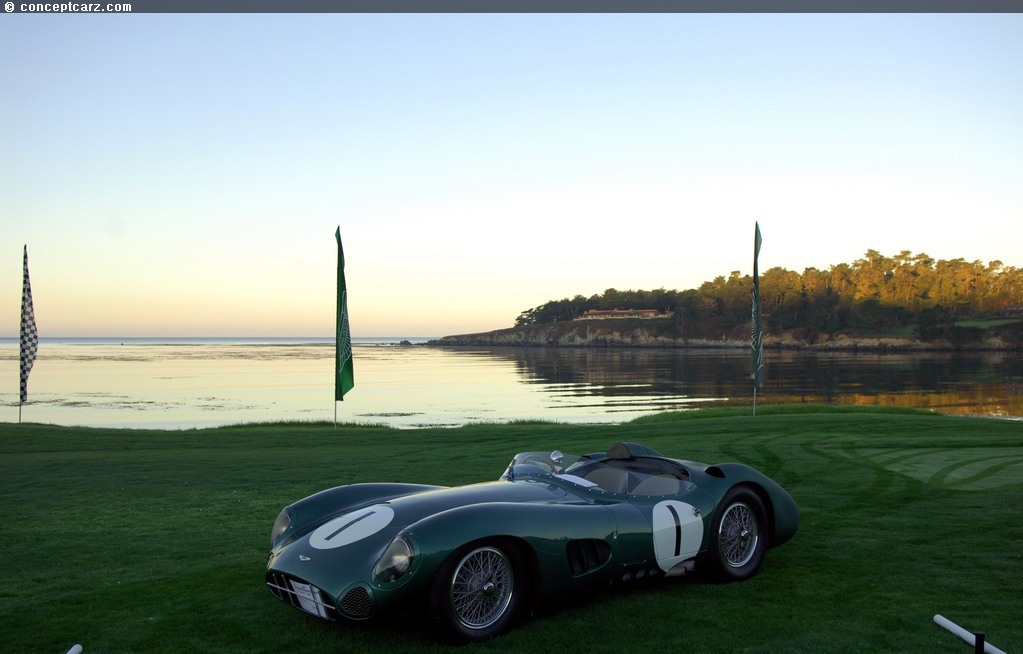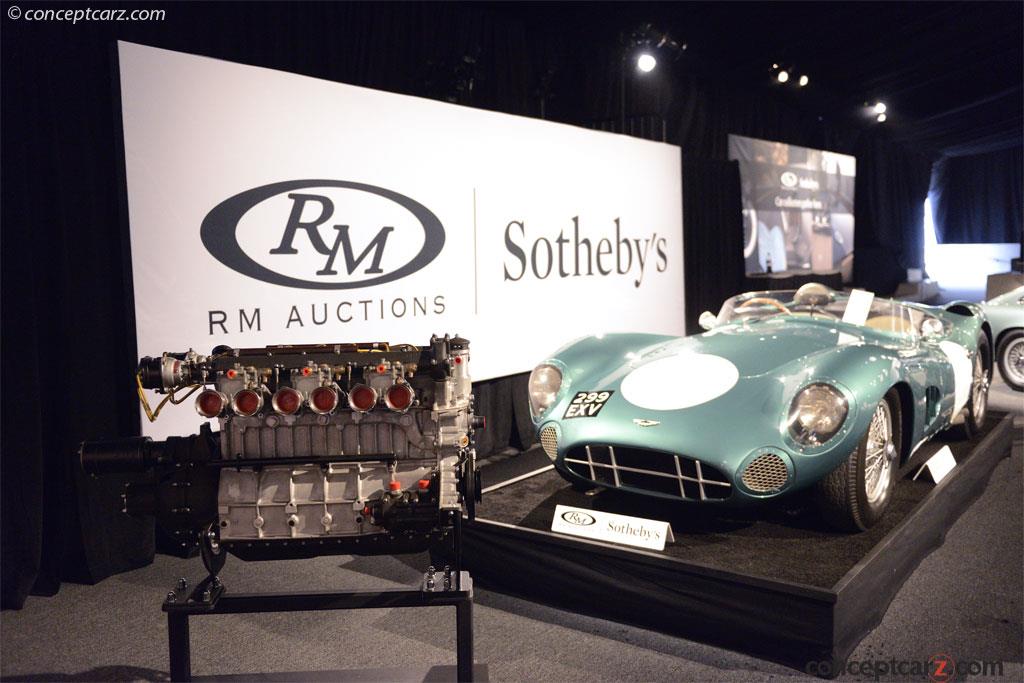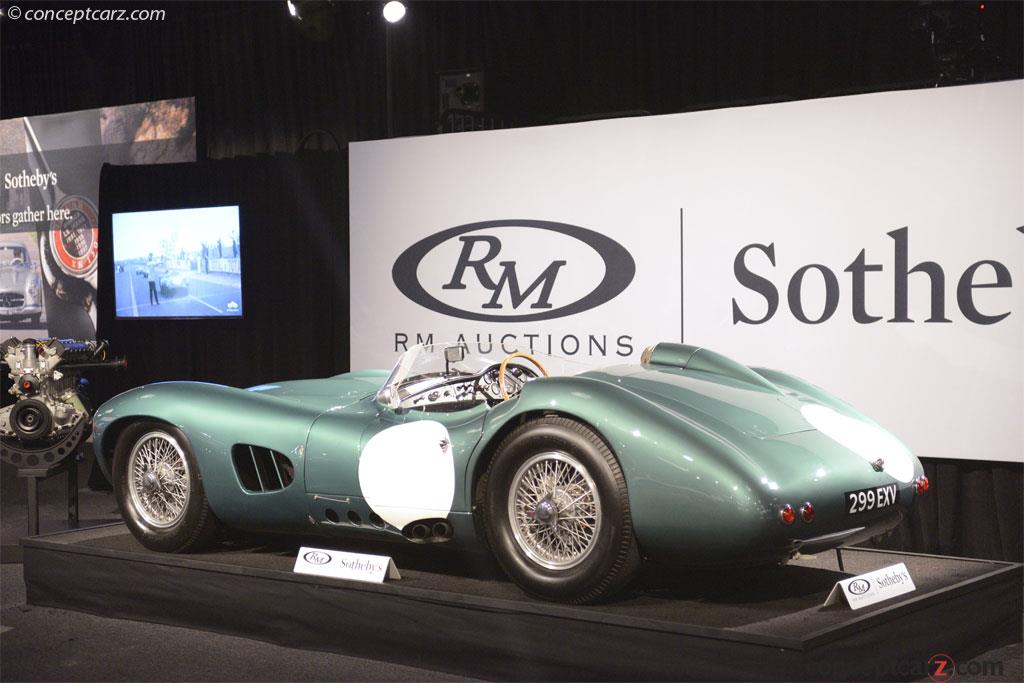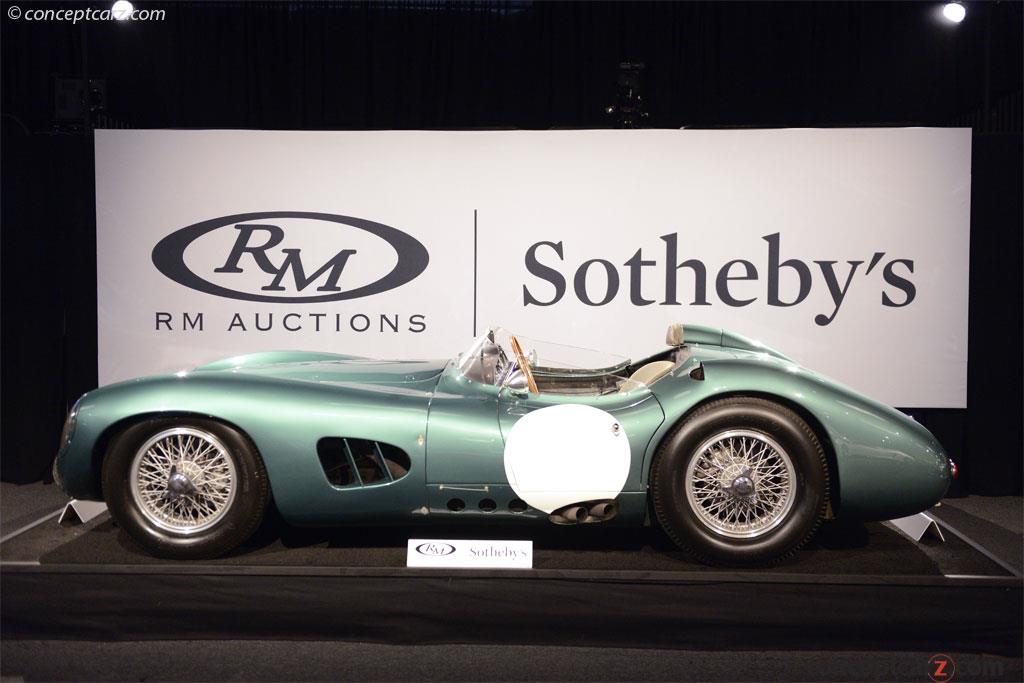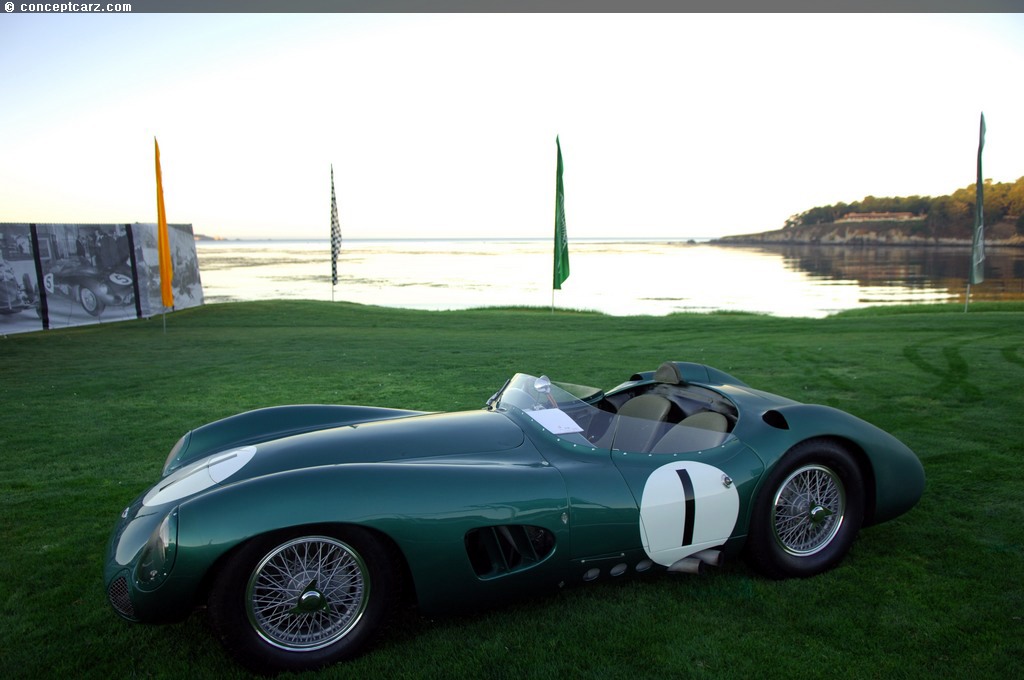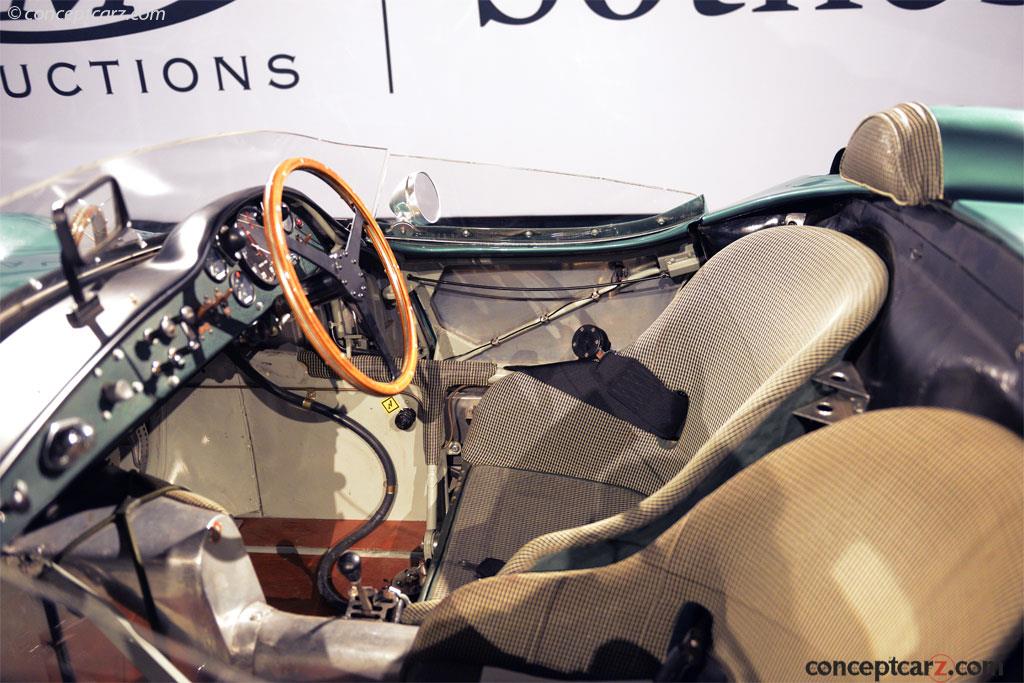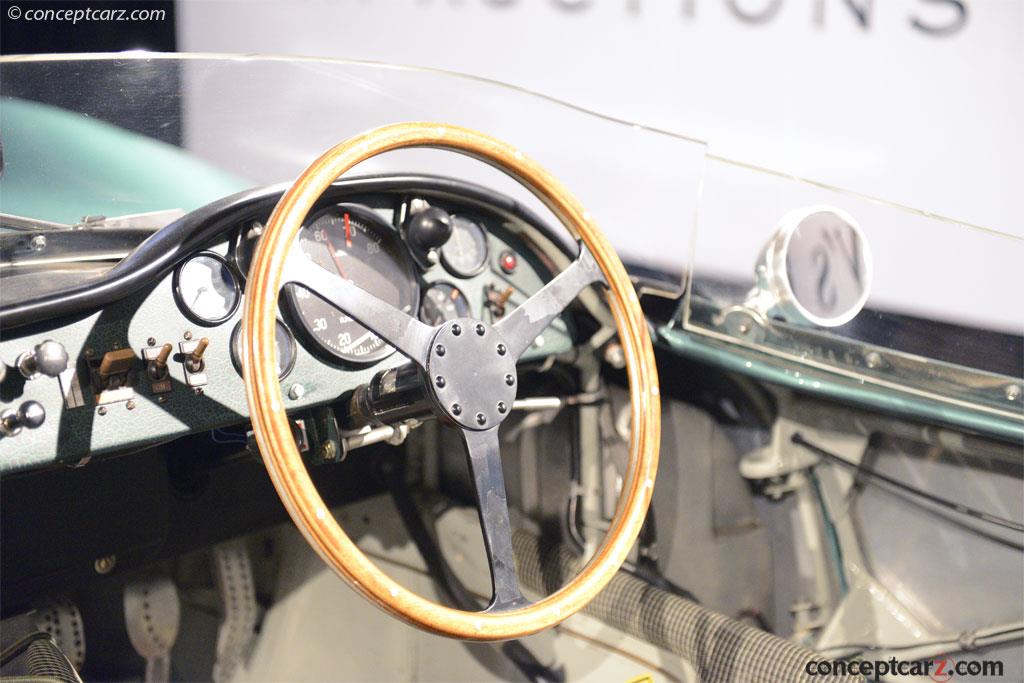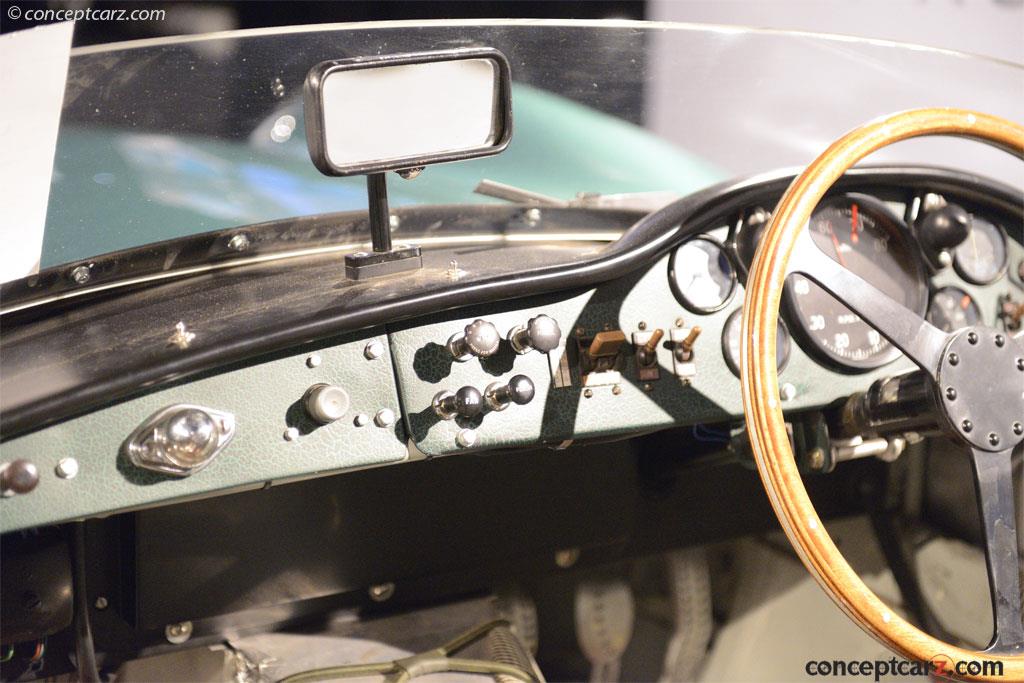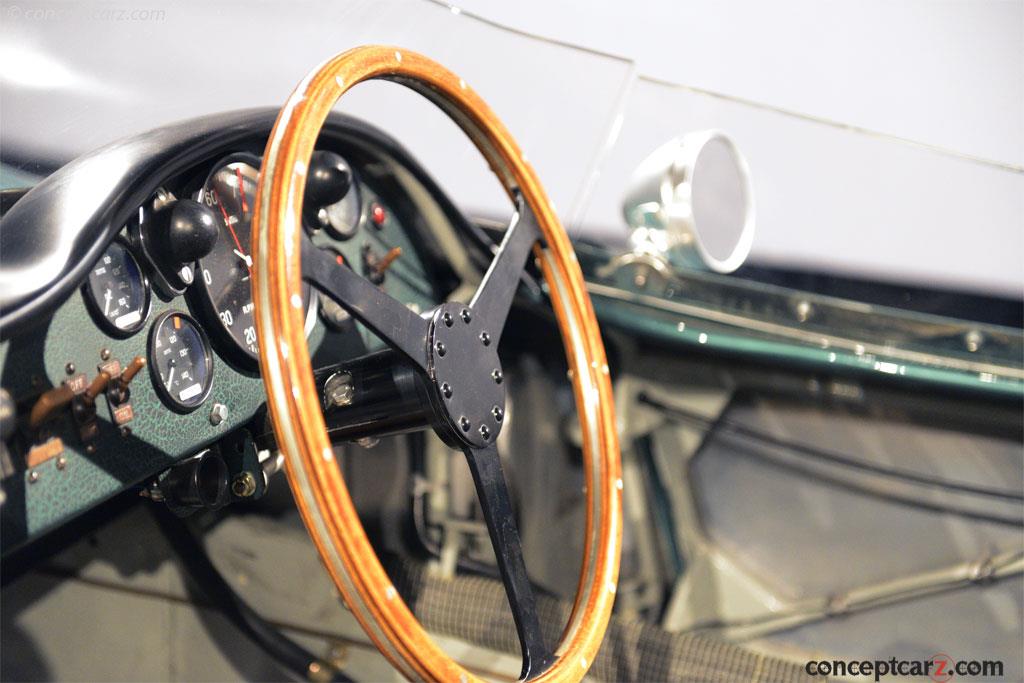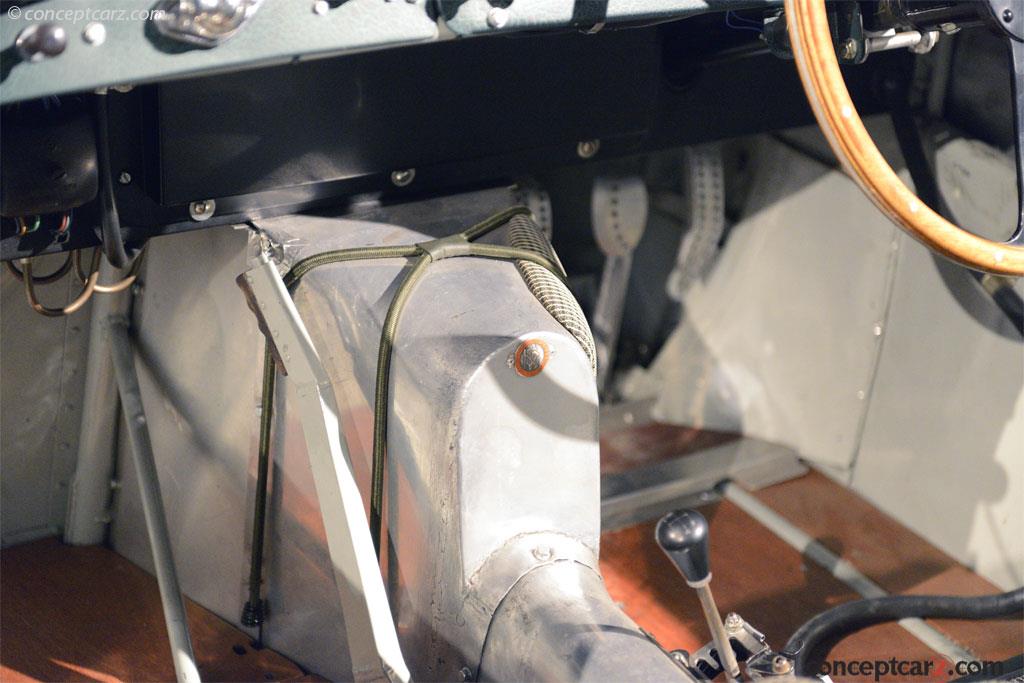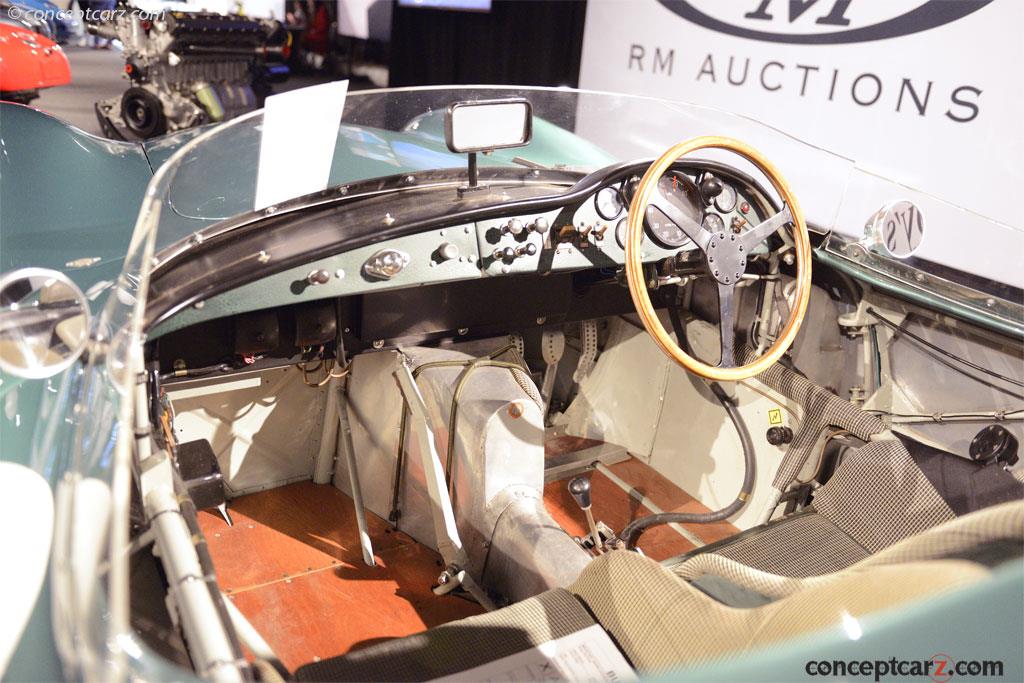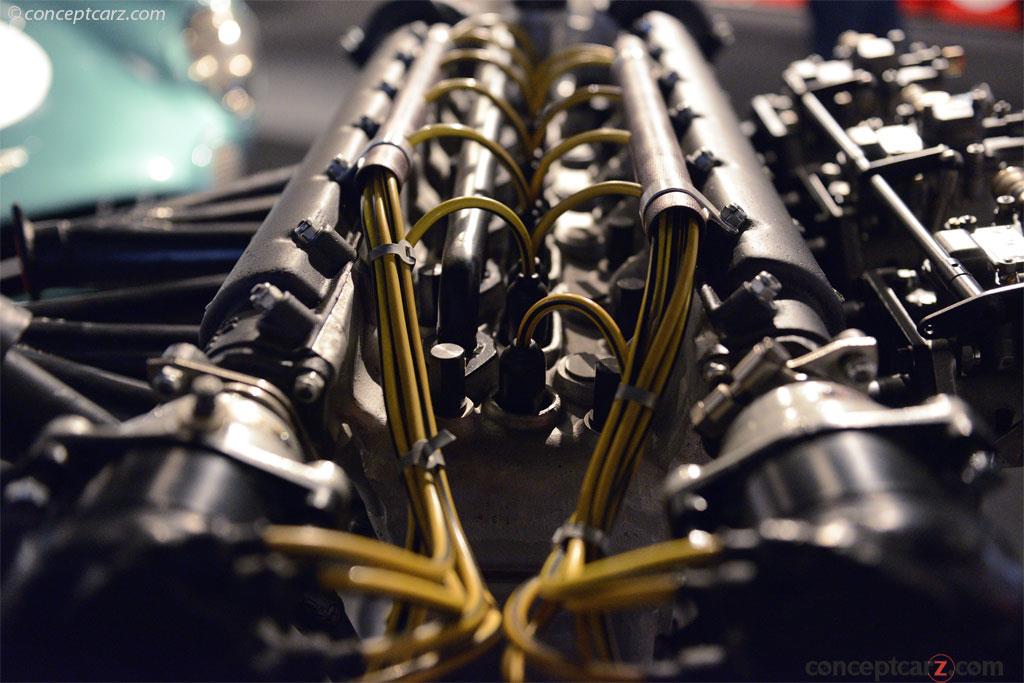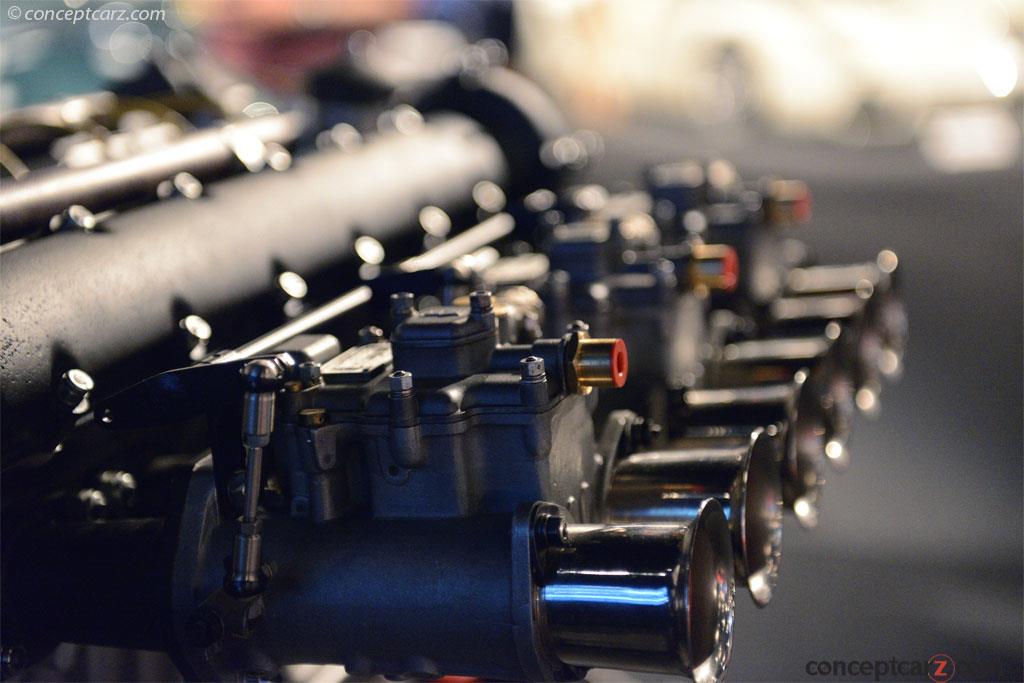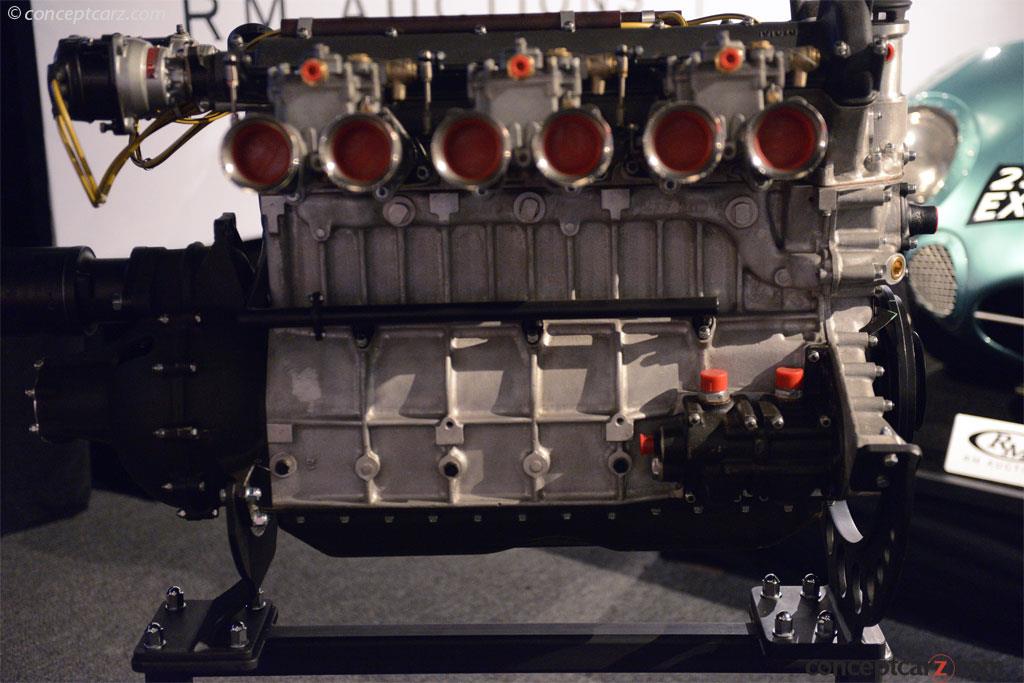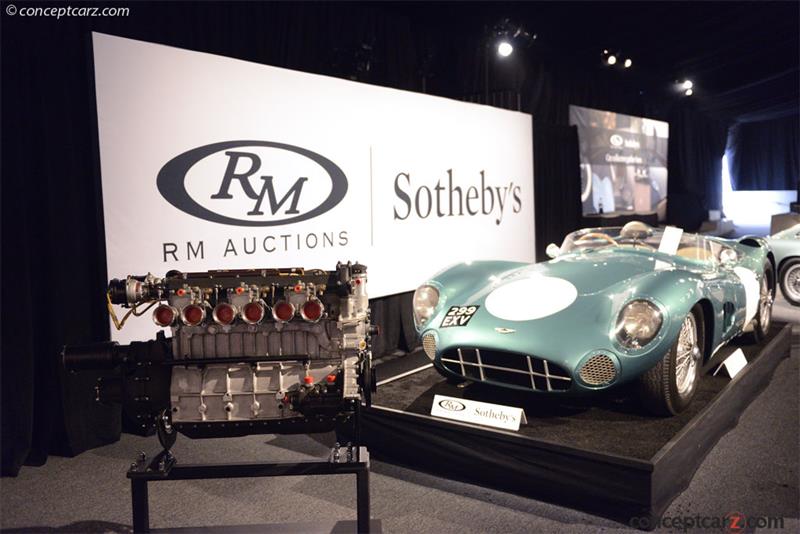Image credit: © conceptcarz.com (Reproduction Or reuse prohibited).
Gearbox manufacturer David Brown purchased Aston Martin in 1946. Soon after, he purchased the Lagonda rights along with designs of a six-cylinder engine with two overhead camshafts. This was one of the last designs of W.O. Bentley. The engine would be used by Aston Martin in achieving many of the motorsports successes through the early-to-mid 1950s.
In 1953, Aston Martin introduced the three-liter DB3S which captured many victories from the company, including a 1-2-3 victory at the 1954 Silverstone Unlimited Sportscar race. Another highlight was a second place finish in the 1955 24 Hours of Le Mans.
In early 1956, work began on a new car utilizing a new spaceframe type chassis designed by chief designer Ted Cutting. It was both lighter and more rigid than the preceding DB3S. The Lockheed disc brakes and much of the suspension were sourced from the latest specification DB3S.
The first DBR1 produced was chassis number 1 and it came powered by a 2.5-liter version of the twin-cam six-cylinder engine mated to a David Brown gearbox. It made its racing debut in the 1956 24 Hours of LeMans where it was driven by Tony Brooks and Reg Parnell. After failing to keep pace with the front runners, the car eventually retired due to an engine problem. This would be the only race outing of the DBR1 in 1956.
The 1956 prototype regulations had stipulated a maximum 2.5-liter capacity and 28 gallon fuel tank. The RB6 engine in the Aston Martin displaced 2,493cc and produced 212 horsepower.
At the close of the 1956 season, John Wyer was General Manager and Reg Parnell as Racing Manager of the company. Under their leader, development and work continued on the DBR1 throughout the winter.
The DBR1/1 raced at the first two events of the 1957 season where it recorded second place finishes at each event. (The British Empire Trophy and Easter Goodwood meetings).
In May of that year, DBR1/1 was joined by DBR1/2 at Spa, both having 3 liter engines. DBR1/2 was driven by Brookes to victory, the first for the DBR1. Roy Salvadori finished 2nd in DBR1/1. A further two victories were earned by Brooks in DBR1/2 that season, in the Nürburgring 1000 km race and again at Spa in a three hour race. Brooks/Noel Cunningham-Reid led the Nürburgring 1000 KM from flag to finish in DBR1/2 with Salvadori/Les Leston in DBR1/1 6th.
At LeMans, Brooks was running 2nd with Cunningham-Reid in DBR1/2, crashed trying to engage gear and Salvadori/Leston retired DBR1/1 with a fractured oil pipe.
Salvadori finished 2nd in the British Grand Prix support race and a 4th at the Belgian Grand Prix with DBR1/1.
At the end of the 1957 season, racing regulations were announced which limited the displacement to 3-liters for sports prototype. This suited Aston Martin and their DBR1 just fine, making Jaguar's D-Types and Maserati's 450S obsolete. Due to financial difficulties, Maserati announced it would withdraw from competition, leaving Ferrari as the sole Works competition.
Aston Martin entered the 1958 racing season with three DBR1 chassis. At the 12 Hours of Sebring, DBR1/2 retired due to gearbox problems. This was after Moss had set a new lap record. Salvadori and Carroll Shelby drove DBR1/1 until a cracked chassis forced them out of the race.
At the Nürburgring, Moss shared DBR1/3 with Jack Brabham. They won by four minutes. DBR1/1 was driven by Shelby and Salvadori, but did not finish due to gearbox failure. 4th-placed Brooks/Stuart Lewis-Evans in DBR1/2 were forced off the road.
At the Targa Florio, Moss was forced to retire due to a gearbox failure, again after breaking the lap record.
At LeMans, DBR/1 retired with another broken gearbox, another crashed, and the third retired with engine failure while leading. A DB3S claimed second place for Aston Martin, behind the victorious Ferrari.
At the Tourist Trophy, DBR1/2 was driven to victory by Moss and Brooks. Salvador and Brabham placed second in DBR1/1 and Shelby and Lewis-Evans placed third in DBR1/3.
At the end of the season, Aston Martin had earned enough points to secure a second place in the Constructor's Championship behind Ferrari.
For the 1959 season, DBR1/1 was driven by Salvadori and Shelby at Sebring. It was forced to retire due to a clutch failure. At the Nürburgring 1000 KM, Moss drove DBR1/1. He broke the lap record 16 times in one of his greatest drives, capturing the third consecutive victory for the DBR1 at the Nürburgring. This would be the final works race entry for DBR1/1.
At the Goodwood's Tourist Trophy race, DBR1/1 served as a practice car.
In August of 1959, Aston Martin withdrew from competition. DBR1/1 would twice race for Essex Racing Stables in the Nürburgring 1000 KM, with Jim Clark/Bruce McLaren retiring from fourth in 1961 when a con-rod failed at 500 KM and McLaren/Tony Maggs finishing 4th in 1962, at the end of which Aston sold DBR1/1 to the Hon. John Dawnay and his brother the Hon. James Dawnay. It was road registered on October 5th of 1962.
Both brothers raced the car until Hon. James Dawnay crashed at Silverstone in 1963, sustaining bad front body damage. The car was returned to the Feltham Works where the body was removed and saved from being scrapped nearly a year later and the car taken to Aston specialist RS Williams. It remained nearly untouched for the next 12 years. In 1976, it moved to Geoffrey Marsh who, having made a body buck from DBR1/2 which he was rebuilding, had a new front section fabricated and the remaining body refurbished; the mechanical components and engine were also rebuilt.
After the work was completed, DBR1/1 returned in 1980 to RSW for race preparation. It was later driven by Mike Salmon to many victories and podiums in Lloyds and Scottish Historic Championship/AMOC races during the early 1980s, including winning outright the 1982 Lloyds & Scottish Historic Car Championship.
In 2000 the car was sold to John McCaw. The current caretaker acquired the DBR1/1 from McCaw in January of 2009.
The car's original engine, RB6/300/3, remains with the car but does not reside in the engine bay. The current owner had R.S. Williams produce another race unit with new cylinder blocks and head.
Since 2010 DBR1/1 has been successfully raced at Goodwood by Brian Redman, while in 2013 Sir Stirling Moss drove it during Aston's centenary celebrations at Nürburgring.
In 2017, the car was consigned to RM Sotheby's for sale at their Monterey Auction where the car had a pre-sale estimated value of over $20 million US dollars.By Daniel Vaughan | Nov 2017
In 1953, Aston Martin introduced the three-liter DB3S which captured many victories from the company, including a 1-2-3 victory at the 1954 Silverstone Unlimited Sportscar race. Another highlight was a second place finish in the 1955 24 Hours of Le Mans.
In early 1956, work began on a new car utilizing a new spaceframe type chassis designed by chief designer Ted Cutting. It was both lighter and more rigid than the preceding DB3S. The Lockheed disc brakes and much of the suspension were sourced from the latest specification DB3S.
The first DBR1 produced was chassis number 1 and it came powered by a 2.5-liter version of the twin-cam six-cylinder engine mated to a David Brown gearbox. It made its racing debut in the 1956 24 Hours of LeMans where it was driven by Tony Brooks and Reg Parnell. After failing to keep pace with the front runners, the car eventually retired due to an engine problem. This would be the only race outing of the DBR1 in 1956.
The 1956 prototype regulations had stipulated a maximum 2.5-liter capacity and 28 gallon fuel tank. The RB6 engine in the Aston Martin displaced 2,493cc and produced 212 horsepower.
At the close of the 1956 season, John Wyer was General Manager and Reg Parnell as Racing Manager of the company. Under their leader, development and work continued on the DBR1 throughout the winter.
The DBR1/1 raced at the first two events of the 1957 season where it recorded second place finishes at each event. (The British Empire Trophy and Easter Goodwood meetings).
In May of that year, DBR1/1 was joined by DBR1/2 at Spa, both having 3 liter engines. DBR1/2 was driven by Brookes to victory, the first for the DBR1. Roy Salvadori finished 2nd in DBR1/1. A further two victories were earned by Brooks in DBR1/2 that season, in the Nürburgring 1000 km race and again at Spa in a three hour race. Brooks/Noel Cunningham-Reid led the Nürburgring 1000 KM from flag to finish in DBR1/2 with Salvadori/Les Leston in DBR1/1 6th.
At LeMans, Brooks was running 2nd with Cunningham-Reid in DBR1/2, crashed trying to engage gear and Salvadori/Leston retired DBR1/1 with a fractured oil pipe.
Salvadori finished 2nd in the British Grand Prix support race and a 4th at the Belgian Grand Prix with DBR1/1.
At the end of the 1957 season, racing regulations were announced which limited the displacement to 3-liters for sports prototype. This suited Aston Martin and their DBR1 just fine, making Jaguar's D-Types and Maserati's 450S obsolete. Due to financial difficulties, Maserati announced it would withdraw from competition, leaving Ferrari as the sole Works competition.
Aston Martin entered the 1958 racing season with three DBR1 chassis. At the 12 Hours of Sebring, DBR1/2 retired due to gearbox problems. This was after Moss had set a new lap record. Salvadori and Carroll Shelby drove DBR1/1 until a cracked chassis forced them out of the race.
At the Nürburgring, Moss shared DBR1/3 with Jack Brabham. They won by four minutes. DBR1/1 was driven by Shelby and Salvadori, but did not finish due to gearbox failure. 4th-placed Brooks/Stuart Lewis-Evans in DBR1/2 were forced off the road.
At the Targa Florio, Moss was forced to retire due to a gearbox failure, again after breaking the lap record.
At LeMans, DBR/1 retired with another broken gearbox, another crashed, and the third retired with engine failure while leading. A DB3S claimed second place for Aston Martin, behind the victorious Ferrari.
At the Tourist Trophy, DBR1/2 was driven to victory by Moss and Brooks. Salvador and Brabham placed second in DBR1/1 and Shelby and Lewis-Evans placed third in DBR1/3.
At the end of the season, Aston Martin had earned enough points to secure a second place in the Constructor's Championship behind Ferrari.
For the 1959 season, DBR1/1 was driven by Salvadori and Shelby at Sebring. It was forced to retire due to a clutch failure. At the Nürburgring 1000 KM, Moss drove DBR1/1. He broke the lap record 16 times in one of his greatest drives, capturing the third consecutive victory for the DBR1 at the Nürburgring. This would be the final works race entry for DBR1/1.
At the Goodwood's Tourist Trophy race, DBR1/1 served as a practice car.
In August of 1959, Aston Martin withdrew from competition. DBR1/1 would twice race for Essex Racing Stables in the Nürburgring 1000 KM, with Jim Clark/Bruce McLaren retiring from fourth in 1961 when a con-rod failed at 500 KM and McLaren/Tony Maggs finishing 4th in 1962, at the end of which Aston sold DBR1/1 to the Hon. John Dawnay and his brother the Hon. James Dawnay. It was road registered on October 5th of 1962.
Both brothers raced the car until Hon. James Dawnay crashed at Silverstone in 1963, sustaining bad front body damage. The car was returned to the Feltham Works where the body was removed and saved from being scrapped nearly a year later and the car taken to Aston specialist RS Williams. It remained nearly untouched for the next 12 years. In 1976, it moved to Geoffrey Marsh who, having made a body buck from DBR1/2 which he was rebuilding, had a new front section fabricated and the remaining body refurbished; the mechanical components and engine were also rebuilt.
After the work was completed, DBR1/1 returned in 1980 to RSW for race preparation. It was later driven by Mike Salmon to many victories and podiums in Lloyds and Scottish Historic Championship/AMOC races during the early 1980s, including winning outright the 1982 Lloyds & Scottish Historic Car Championship.
In 2000 the car was sold to John McCaw. The current caretaker acquired the DBR1/1 from McCaw in January of 2009.
The car's original engine, RB6/300/3, remains with the car but does not reside in the engine bay. The current owner had R.S. Williams produce another race unit with new cylinder blocks and head.
Since 2010 DBR1/1 has been successfully raced at Goodwood by Brian Redman, while in 2013 Sir Stirling Moss drove it during Aston's centenary celebrations at Nürburgring.
In 2017, the car was consigned to RM Sotheby's for sale at their Monterey Auction where the car had a pre-sale estimated value of over $20 million US dollars.By Daniel Vaughan | Nov 2017
2017 RM Sothebys : Monterey
Sale Price :
USD $22,500,000
Recent Sales of the Aston Martin DBR1
(Data based on Model Year 1956 sales)
| 1956 Aston Martin DBR1 Chassis#: DBR1/1 Sold for USD$22,500,000 2017 RM Sothebys : Monterey |   |
Aston Martin DBR1s That Failed To Sell At Auction
1956 Aston Martin DBR1's that have appeared at auction but did not sell.
| Vehicle | Chassis | Event | High Bid | Est. Low | Est. High |
|---|
Vehicles With Comparable Market Values
Similar sales to the $22,500,000 range.
| 1955 Ferrari 410 Sport Spider by Scaglietti Chassis#:0598 CM Sold for $22,005,000 2022 RM Sothebys : Monterey |   |
| 1995 McLaren F1 Chassis#:SA9AB5AC9S1048029 Sold for $20,465,000 2021 Gooding & Company : Pebble Beach Concours Auction |   |
| 1956 Ferrari 290 MM by Scaglietti Chassis#:0628 Sold for $22,005,000 2018 RM Sothebys : The Petersen Automotive Museum |   |
| 1963 Aston Martin DP215 Grand Touring Competition Prototype Chassis#:DP215 Sold for $21,455,000 2018 RM Sothebys : Monterey |   |
| 1935 Duesenberg SSJ Chassis#:2594 Sold for $22,000,000 2018 Gooding & Company : Pebble Beach |   |
| 1955 Jaguar D-Type Chassis#:XKD 501 Sold for $21,780,000 2016 RM Sotheby's : Monterey |   |
| 1955 Ferrari 410 Sport Chassis#:0592CM Sold for $23,000,000 2014 Rick Cole Auctions : Monterey |   |
1956 Aston Martin DBR1
• Additional valuation insight and sales data• History
• Specifications
• Image gallery
• Other Aston Martin DBR1 model years
